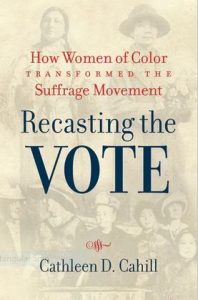As a WGSS major and a student who has been interested in women’s movements for most of my life, I have studied the suffrage movement in many classes and discussed it in different contexts. However, this Clarke Forum presentation put forth a new way of looking at the suffrage movement with new names, ideas, and facts that are vital to understanding the movement as a whole.
This talk, given by social historian Cathleen Cahill, focused on stories about women of color suffragists who are not visible within the mainstream narrative of the suffrage movement. Cahill spoke of three “major moments” in the suffrage movement, and showed them in a different light than history normally teaches. She discussed the 1912 NYC Suffrage Parade, the 1913 Washington DC Suffrage Parade, and the ratification of the 19th Amendment. She wove, within this time frame, the stories of women of color and their communities; specifically Dr. Mabel Ping Hua Lee, Marie Louise Bottineau Baldwin, Ida B. Wells-Barnett, and Nina Otero-Warren.
Two things struck me intensely, in that I have never even heard of them while learning about the suffrage movement. One was the involvement of Chinese-American women in the movement, and the reaction of white people to them. In this narrative, the Chinese-American women still had to be “included” by the white suffragists to get their voices heard in the greater movement, yet they were doing their own work and had so much to say and add to the women’s movement. White suffragists only used these women’s perspectives when they felt it could help them further their own cause, not necessarily the cause of Chinese-American women. As Cahill says, “their activism focused on the particular problems of their communities.” To the Chinese-American activists, the suffrage movement was just one part of becoming seen and being treated as Americans and as equal humans.
Another aspect of the talk that I thought was particularly interesting was the fact that the 19th amendment did not apply to either Native women or men, as it also left out many other groups. Native Americans were not necessarily citizens of the United States, which meant they were not included in the right to vote. Cahill points out that not all Native American people wanted citizenship, which is important to think about when learning the history of women’s suffrage, and Native American history. The right to vote is just one layer of the struggles of Native Americans, and one for which not all Native Americans agreed upon the solution.
Thinking back on my education about the suffrage movement, I am disgusted by how white-washed it is. However, this doesn’t surprise me, as the way we learn all of American history is like this. One memory comes to mind the most, and that is when I visited a museum in D.C. dedicated to women of the suffrage movement. Places like this are full of white women, with the occasional tribute to Ida B. Wells. This paints such an inaccurate, destructive image in girls’ minds, that white women did all of the work and were met with ultimate success, when this is not at all the case. White women did not do all of the work, yet the women of color who did do so much did not reach the goal of equality and suffrage in the same way or at the same time as those white women. This is important history to teach, and I am so glad that Cathleen Cahill’s scholarship is doing some of that.
Written by Sophie Ackert ’21, WGRC student worker
September 18, 2020